Attached files
| file | filename |
|---|---|
| 8-K - CURRENT REPORT - Corindus Vascular Robotics, Inc. | cvrs-8k_090816.htm |
Corindus Vascular Robotics, Inc. 8-K
Ex 99.1
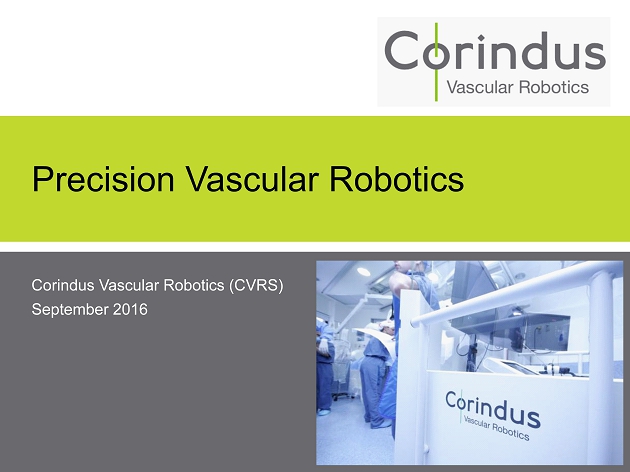
Precision Vascular Robotics Corindus Vascular Robotics (CVRS) September 2016
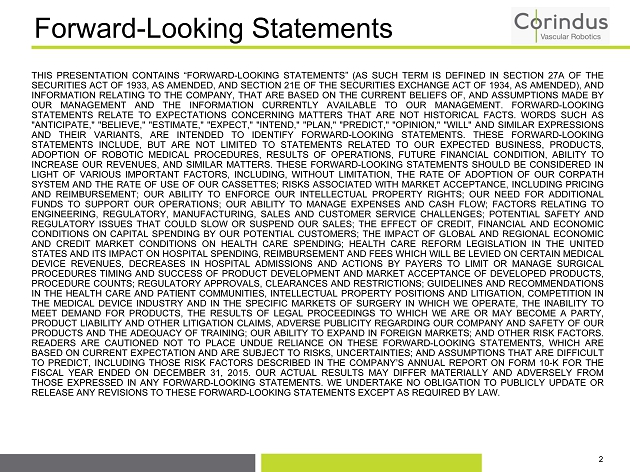
THIS PRESENTATION CONTAINS “FORWARD - LOOKING STATEMENTS” (AS SUCH TERM IS DEFINED IN SECTION 27 A OF THE SECURITIES ACT OF 1933 , AS AMENDED, AND SECTION 21 E OF THE SECURITIES EXCHANGE ACT OF 1934 , AS AMENDED), AND INFORMATION RELATING TO THE COMPANY, THAT ARE BASED ON THE CURRENT BELIEFS OF, AND ASSUMPTIONS MADE BY OUR MANAGEMENT AND THE INFORMATION CURRENTLY AVAILABLE TO OUR MANAGEMENT . FORWARD - LOOKING STATEMENTS RELATE TO EXPECTATIONS CONCERNING MATTERS THAT ARE NOT HISTORICAL FACTS . WORDS SUCH AS "ANTICIPATE," "BELIEVE," "ESTIMATE," "EXPECT," "INTEND," "PLAN," "PREDICT," "OPINION," "WILL" AND SIMILAR EXPRESSIONS AND THEIR VARIANTS, ARE INTENDED TO IDENTIFY FORWARD - LOOKING STATEMENTS . THESE FORWARD - LOOKING STATEMENTS INCLUDE, BUT ARE NOT LIMITED TO STATEMENTS RELATED TO OUR EXPECTED BUSINESS, PRODUCTS, ADOPTION OF ROBOTIC MEDICAL PROCEDURES, RESULTS OF OPERATIONS, FUTURE FINANCIAL CONDITION, ABILITY TO INCREASE OUR REVENUES, AND SIMILAR MATTERS . THESE FORWARD - LOOKING STATEMENTS SHOULD BE CONSIDERED IN LIGHT OF VARIOUS IMPORTANT FACTORS, INCLUDING, WITHOUT LIMITATION, THE RATE OF ADOPTION OF OUR CORPATH SYSTEM AND THE RATE OF USE OF OUR CASSETTES ; RISKS ASSOCIATED WITH MARKET ACCEPTANCE, INCLUDING PRICING AND REIMBURSEMENT ; OUR ABILITY TO ENFORCE OUR INTELLECTUAL PROPERTY RIGHTS ; OUR NEED FOR ADDITIONAL FUNDS TO SUPPORT OUR OPERATIONS ; OUR ABILITY TO MANAGE EXPENSES AND CASH FLOW ; FACTORS RELATING TO ENGINEERING, REGULATORY, MANUFACTURING, SALES AND CUSTOMER SERVICE CHALLENGES ; POTENTIAL SAFETY AND REGULATORY ISSUES THAT COULD SLOW OR SUSPEND OUR SALES ; THE EFFECT OF CREDIT, FINANCIAL AND ECONOMIC CONDITIONS ON CAPITAL SPENDING BY OUR POTENTIAL CUSTOMERS ; THE IMPACT OF GLOBAL AND REGIONAL ECONOMIC AND CREDIT MARKET CONDITIONS ON HEALTH CARE SPENDING ; HEALTH CARE REFORM LEGISLATION IN THE UNITED STATES AND ITS IMPACT ON HOSPITAL SPENDING, REIMBURSEMENT AND FEES WHICH WILL BE LEVIED ON CERTAIN MEDICAL DEVICE REVENUES, DECREASES IN HOSPITAL ADMISSIONS AND ACTIONS BY PAYERS TO LIMIT OR MANAGE SURGICAL PROCEDURES TIMING AND SUCCESS OF PRODUCT DEVELOPMENT AND MARKET ACCEPTANCE OF DEVELOPED PRODUCTS, PROCEDURE COUNTS ; REGULATORY APPROVALS, CLEARANCES AND RESTRICTIONS ; GUIDELINES AND RECOMMENDATIONS IN THE HEALTH CARE AND PATIENT COMMUNITIES, INTELLECTUAL PROPERTY POSITIONS AND LITIGATION, COMPETITION IN THE MEDICAL DEVICE INDUSTRY AND IN THE SPECIFIC MARKETS OF SURGERY IN WHICH WE OPERATE, THE INABILITY TO MEET DEMAND FOR PRODUCTS, THE RESULTS OF LEGAL PROCEEDINGS TO WHICH WE ARE OR MAY BECOME A PARTY, PRODUCT LIABILITY AND OTHER LITIGATION CLAIMS, ADVERSE PUBLICITY REGARDING OUR COMPANY AND SAFETY OF OUR PRODUCTS AND THE ADEQUACY OF TRAINING ; OUR ABILITY TO EXPAND IN FOREIGN MARKETS ; AND OTHER RISK FACTORS . READERS ARE CAUTIONED NOT TO PLACE UNDUE RELIANCE ON THESE FORWARD - LOOKING STATEMENTS, WHICH ARE BASED ON CURRENT EXPECTATION AND ARE SUBJECT TO RISKS, UNCERTAINTIES ; AND ASSUMPTIONS THAT ARE DIFFICULT TO PREDICT, INCLUDING THOSE RISK FACTORS DESCRIBED IN THE COMPANY’S ANNUAL REPORT ON FORM 10 - K FOR THE FISCAL YEAR ENDED ON DECEMBER 31 , 2015 . OUR ACTUAL RESULTS MAY DIFFER MATERIALLY AND ADVERSELY FROM THOSE EXPRESSED IN ANY FORWARD - LOOKING STATEMENTS . WE UNDERTAKE NO OBLIGATION TO PUBLICLY UPDATE OR RELEASE ANY REVISIONS TO THESE FORWARD - LOOKING STATEMENTS EXCEPT AS REQUIRED BY LAW . OT AN OFFER Forward - Looking Statements 2
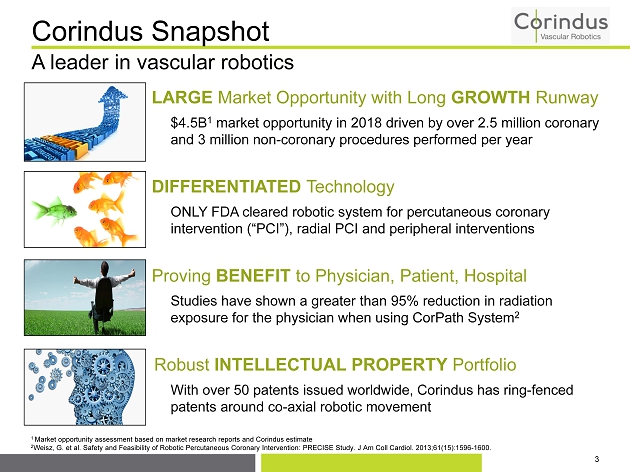
Corindus Snapshot A leader in vascular robotics LARGE Market Opportunity with Long GROWTH Runway $4.5B 1 market opportunity in 2018 driven by over 2.5 million coronary and 3 million non - coronary procedures performed per year DIFFERENTIATED Technology ONLY FDA cleared robotic system for percutaneous coronary intervention (“PCI”), radial PCI and peripheral interventions Proving BENEFIT to Physician, Patient, Hospital Studies have shown a greater than 95% reduction in radiation exposure for the physician when using CorPath System 2 Robust INTELLECTUAL PROPERTY Portfolio With over 50 patents issued worldwide, Corindus has ring - fenced patents around co - axial robotic movement 1 Market opportunity assessment based on market research reports and Corindus estimate 2 Weisz , G. et al. Safety and Feasibility of Robotic Percutaneous Coronary Intervention: PRECISE Study. J Am Coll Cardiol. 2013;61(1 5): 1596 - 1600. 3
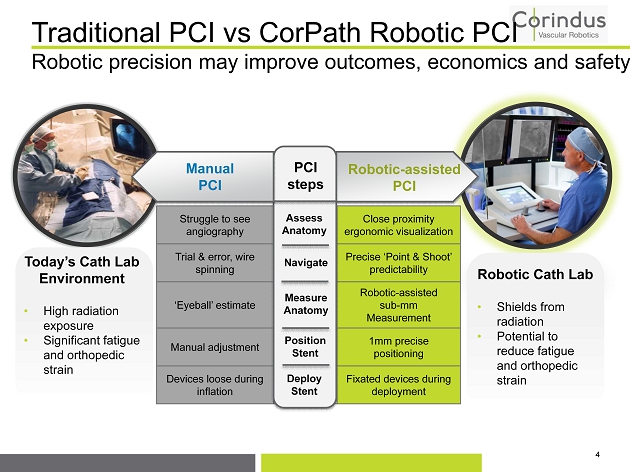
Struggle to see angiography Assess Anatomy Close proximity ergonomic visualization Trial & error, wire spinning Navigate Precise ‘Point & Shoot’ predictability ‘Eyeball’ estimate Measure Anatomy Robotic - assisted sub - mm Measurement Manual adjustment Position Stent 1mm precise positioning Devices loose during inflation Deploy Stent Fixated devices during deployment Manual PCI PCI steps Robotic - assisted PCI Assess Anatomy Navigate Measure Anatomy Position Stent Deploy Stent Traditional PCI vs CorPath Robotic PCI Robotic precision may improve outcomes, economics and safety 4 Today’s Cath Lab Environment • High radiation exposure • Significant fatigue and orthopedic strain Robotic Cath Lab • Shields from radiation • Potential to reduce fatigue and orthopedic strain

New Leadership & Strengthening Team Building operational & clinical e xcellence Mark Toland President & CEO 20 Year Medical D evice V eteran J. Aaron Grantham, MD Chief Medical Officer Practicing Interventional Cardiologist Marty Leon, MD Executive Advisor Interventional Cardiology Thought Leader Campbell Rogers, MD Board of Directors CMO of Heartflow • Additional leadership hires: − R&D − Operations − Sales − Worldwide Strategic Development − Human Resources 5
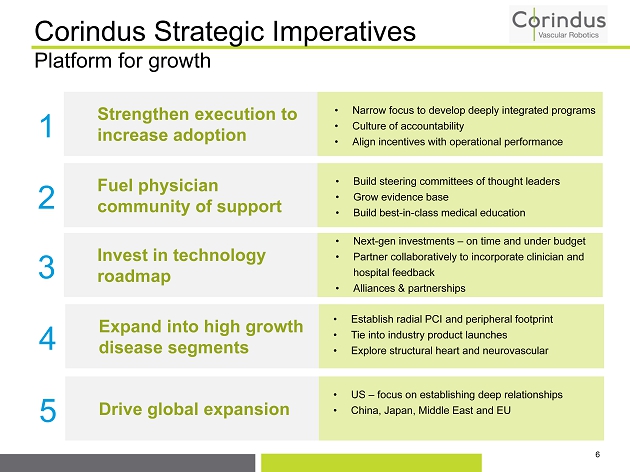
Corindus Strategic Imperatives Platform for growth Strengthen execution to increase adoption 1 Fuel physician community of support 2 Invest in technology roadmap 3 Expand into high growth disease segments 4 Drive global e xpansion 5 • US – focus on establishing deep relationships • China , Japan, Middle East and EU • Establish r adial PCI and peripheral footprint • Tie into industry product launches • Explore structural heart and neurovascular • Build s teering c ommittees of thought leaders • Grow e vidence base • Build b est - i n - c lass m edical e ducation • Next - g en i nvestments – on time and under budget • Partner collaboratively to incorporate clinician and hospital feedback • Alliances & p artnerships • Narrow focus to develop deeply integrated programs • Culture of accountability • Align incentives with operational performance 6
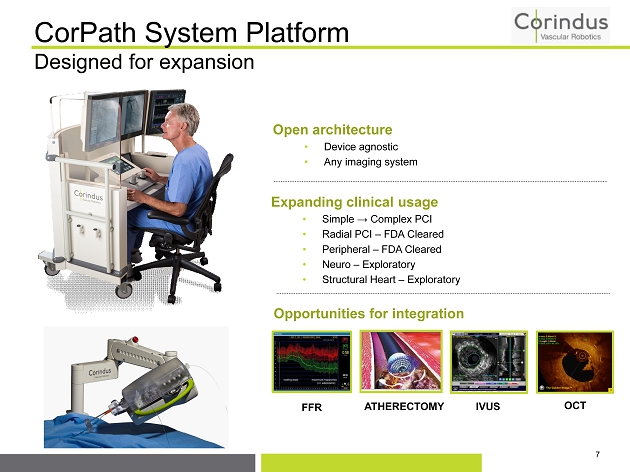
FFR ATHERECTOMY IVUS OCT Opportunities for integration Expanding clinical usage • Simple → Complex PCI • Radial PCI – FDA Cleared • Peripheral – FDA Cleared • Neuro – Exploratory • Structural Heart – Exploratory CorPath System Platform Designed for expansion 7 Open architecture • Device agnostic • Any imaging system
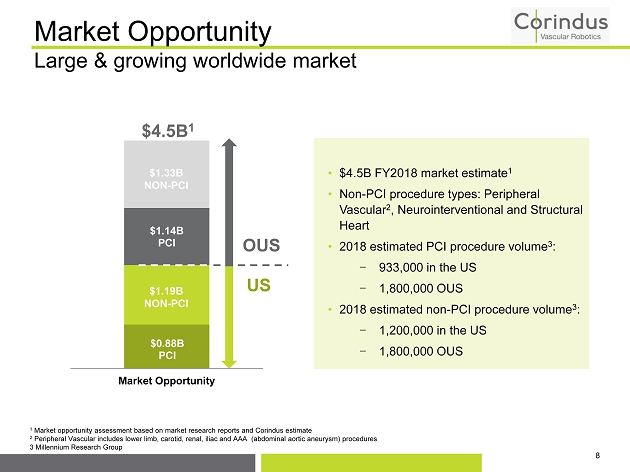
1 Market opportunity assessment based on market research reports and Corindus estimate 2 Peripheral Vascular includes lower limb, carotid, renal, iliac and AAA (abdominal aortic aneurysm) procedures 3 Millennium Research Group Market Opportunity Large & growing worldwide market • $ 4.5B FY2018 market estimate 1 • Non - PCI procedure types: Peripheral Vascular 2 , Neurointerventional and Structural Heart • 2018 estimated PCI procedure volume 3 : − 933,000 in the US − 1,800,000 OUS • 2018 estimated non - PCI procedure volume 3 : − 1,200,000 in the US − 1,800,000 OUS $0.88B PCI $1.14B PCI Market Opportunity OUS US $ 4.5B 1 $ 1.33B NON - PCI $ 1.19B NON - PCI 8
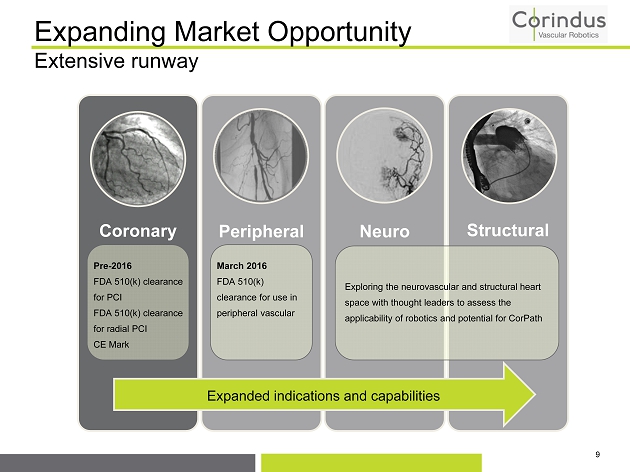
Peripheral (1.5M Procedures) Expanded indications and capabilities Expanding Market Opportunity Extensive runway Coronary Peripheral Neuro Structural March 2016 FDA 510(k) clearance for use in peripheral vascular Exploring the neurovascular and structural heart space with thought leaders to assess the applicability of robotics and potential for CorPath Pre - 2016 FDA 510(k) clearance for PCI FDA 510(k) clearance for radial PCI CE Mark 9
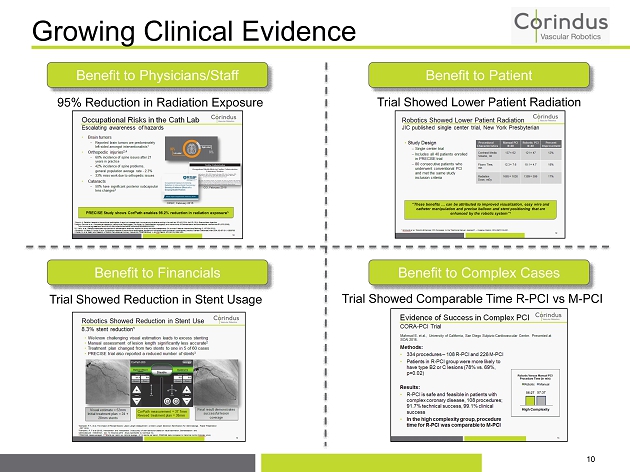
Growing Clinical Evidence Benefit to Physicians/Staff Benefit to Patient Benefit to Financials Benefit to Complex Cases 95% Reduction in Radiation Exposure Trial Showed Lower Patient Radiation Trial Showed Comparable Time R - PCI vs M - PCI Trial Showed Reduction in Stent Usage 10
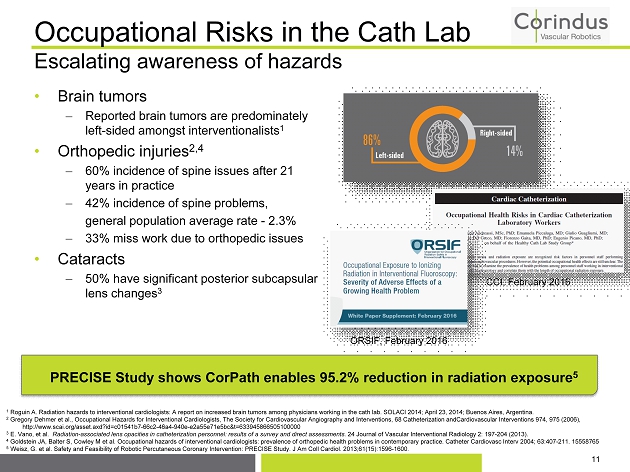
• Brain tumors – Reported brain tumors are predominately left - sided amongst interventionalists 1 • Orthopedic injuries 2,4 – 60% incidence of spine issues after 21 years in practice – 42% incidence of spine problems, general population average rate - 2.3% – 33% miss work due to orthopedic issues • Cataracts – 50% have significant posterior subcapsular lens changes 3 1 Roguin A. Radiation hazards to interventional cardiologists: A report on increased brain tumors among physicians working in t he cath lab. SOLACI 2014; April 23, 2014; Buenos Aires, Argentina. 2 Gregory Dehmer et al., Occupational Hazards for Interventional Cardiologists, The Society for Cardiovascular Angiography and In terventions, 68 Catheterization and Cardiovascular Interventions 974, 975 (2006), http://www.scai.org/asset.axd?id=c01541b7 - 66c2 - 46a4 - 940e - e2a55e71e5bc&t=633945866505100000 3 E. Vano, et al. Radiation - associated lens opacities in catheterization personnel: results of a survey and direct assessments. 24 Journal of Vascular Interventional Radiology 2: 197 - 204 (2013). 4 Goldstein JA, Balter S, Cowley M et al. Occupational hazards of interventional cardiologists: prevalence of orthopedic health p roblems in contemporary practice. Catheter Cardiovasc Interv 2004; 63:407 - 211. 15558765 5 Weisz, G. et al. Safety and Feasibility of Robotic Percutaneous Coronary Intervention: PRECISE Study. J Am Coll Cardiol. 2013 ;61 (15):1596 - 1600 . Occupational Risks in the Cath Lab Escalating awareness of hazards 11 ORSIF, February 2016 CCI, February 2016 PRECISE Study shows CorPath enables 95.2% reduction in radiation exposure 5
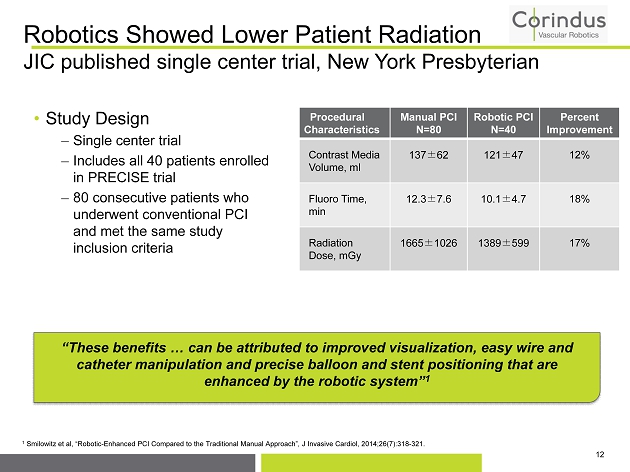
Robotics Showed Lower Patient Radiation JIC published s ingle center trial, New York Presbyterian Procedural Characteristics Manual PCI N=80 Robotic PCI N=40 Percent Improvement Contrast Media Volume, ml 137 ± 62 121 ± 47 12% Fluoro Time, min 12.3 ± 7.6 10.1 ± 4.7 18% Radiation Dose, mGy 1665 ± 1026 1389 ± 599 17% 1 Smilowitz et al, “Robotic - Enhanced PCI Compared to the Traditional Manual Approach”, J Invasive Cardiol, 2014;26(7): 318 - 321. • Study Design – Single center trial – Includes all 40 patients enrolled in PRECISE trial – 80 consecutive patients who underwent conventional PCI and met the same study inclusion criteria “These benefits … can be attributed to improved visualization, easy wire and catheter manipulation and precise balloon and stent positioning that are enhanced by the robotic system” 1 12
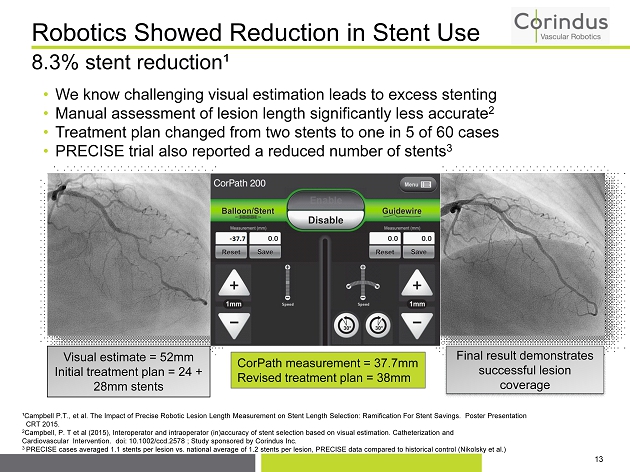
Robotics Showed Reduction in Stent Use 8.3% stent reduction¹ ¹Campbell P.T., et al. The Impact of Precise Robotic Lesion Length Measurement on Stent Length Selection: Ramification For St ent Savings. Poster Presentation CRT 2015. 2 Campbell , P. T et al (2015), Interoperator and intraoperator (in)accuracy of stent selection based on visual estimation. Catheterizat ion and Cardiovascular Intervention. doi: 10.1002/ccd.2578 ; Study sponsored by Corindus Inc . 3 PRECISE cases averaged 1.1 stents per lesion vs. national average of 1.2 stents per lesion, PRECISE data compared to historical control (Nikolsky et al .) CorPath measurement = 37.7mm Revised treatment plan = 38mm • We know challenging visual estimation leads to excess stenting • Manual assessment of lesion length significantly less accurate 2 • Treatment plan changed from two stents to one in 5 of 60 cases • PRECISE trial also reported a reduced n umber of stents 3 Final result demonstrates successful lesion coverage Visual estimate = 52mm Initial treatment plan = 24 + 28mm stents 13
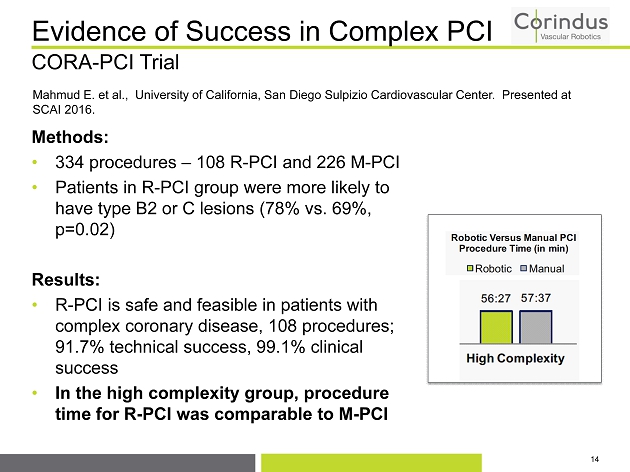
Evidence of Success in Complex PCI Methods: • 334 procedures – 108 R - PCI and 226 M - PCI • Patients in R - PCI group were more likely to have type B2 or C lesions (78% vs. 69%, p=0.02) Results: • R - PCI is safe and feasible in patients with complex coronary disease, 108 procedures; 91.7% technical success, 99.1% clinical success • In the high complexity group, procedure time for R - PCI was comparable to M - PCI CORA - PCI Trial Mahmud E. et al., University of California, San Diego Sulpizio Cardiovascular Center. Presented at SCAI 2016. 14

Evolution of Clinical Strategy Clinician driven deliverables through CMO feedback loop Strategic Shift Leverage Develop Scale • FDA clearance of NG2 (GRX) • Clinical Steering Committee • Technology deep dives with R&D • VP of Medical Affairs • Build clinical roadmap • Gen 3 development underway • Clinical roadmap outlined • Medical education strategy established and in execution mode • Future generation product development • Global expansion • Broader indications • Algorithmic approach to robotics • WW Launch of NG3 • 1 st ever r emote cases performed • Robotic “live” cases at major medical conferences • Outcomes data grows 15
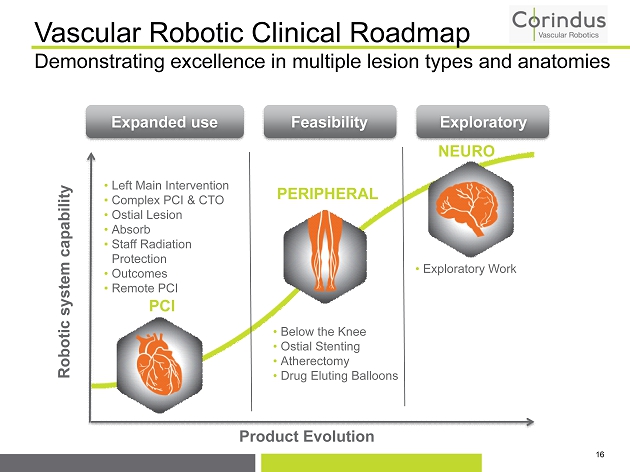
Vascular Robotic Clinical Roadmap Demonstrating excellence in multiple lesion types and anatomies Product Evolution Robotic system capability Exploratory • Below the Knee • Ostial S tenting • Atherectomy • Drug Eluting Balloons • Left Main I ntervention • Complex PCI & CTO • Ostial Lesion • Absorb • Staff Radiation Protection • Outcomes • Remote PCI Feasibility Expanded use • Exploratory Work NEURO PERIPHERAL PCI 16
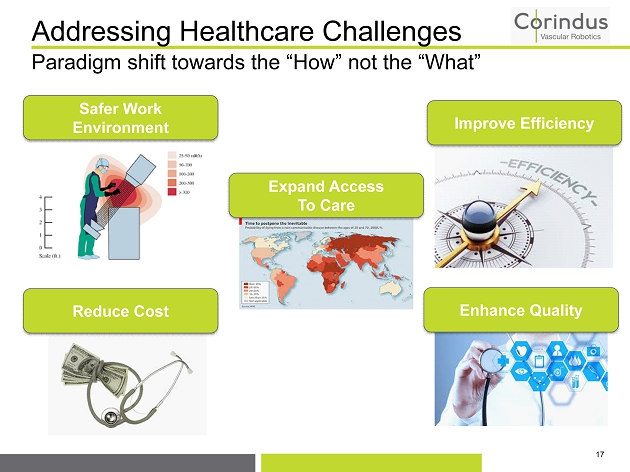
Addressing Healthcare Challenges Paradigm shift t owards the “How” not the “What” Safer Work Environment Improve Efficiency Reduce Cost Enhance Quality Expand Access To Care 17
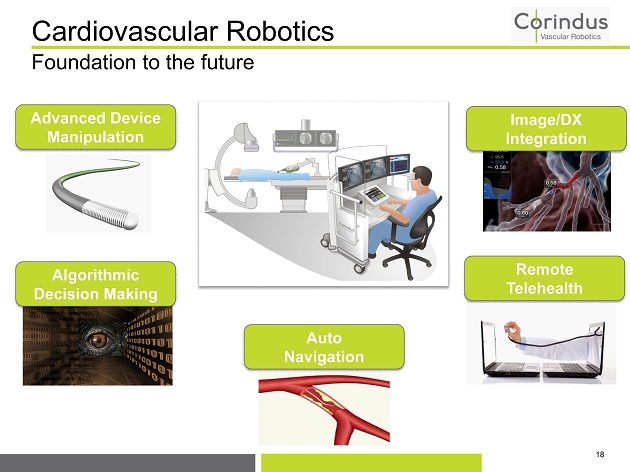
Cardiovascular Robotics Foundation to t he f uture Advanced Device Manipulation Auto Navigation Algorithmic Decision Making Image/DX Integration Remote Telehealth 18
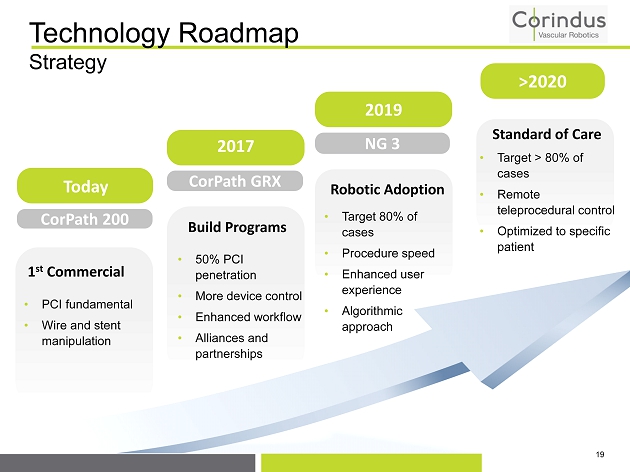
Today 1 st Commercial • PCI fundamental • Wire and stent manipulation Robotic Adoption • Target 80% of cases • Procedure speed • Enhanced user experience • Algorithmic approach > 2020 Standard of Care • Target > 80% of cases • Remote teleprocedural control • Optimized to specific patient CorPath 200 2017 CorPath GRX 2019 NG 3 Technology Roadmap Strategy • 50% PCI penetration • More device control • Enhanced workflow • Alliances and partnerships Build Programs 19
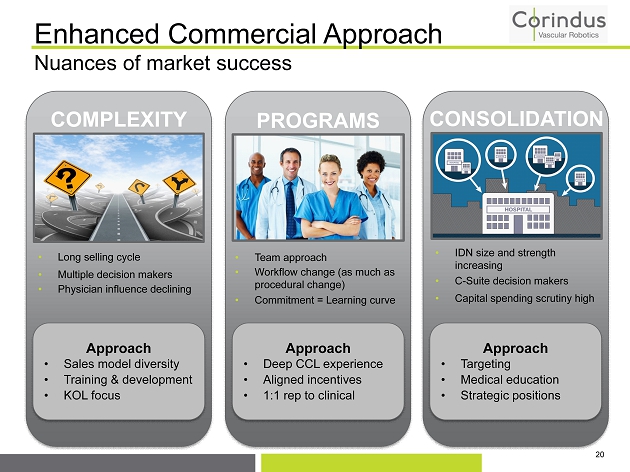
Enhanced Commercial Approach Nuances of market s uccess 20 • Long selling cycle • Multiple decision makers • Physician influence declining COMPLEXITY Approach • Sales model diversity • Training & development • KOL focus • Team approach • Workflow change (as much as procedural change) • Commitment = Learning curve PROGRAMS Approach • Deep CCL experience • Aligned incentives • 1:1 rep to clinical • IDN size and strength increasing • C - Suite decision makers • Capital spending scrutiny high CONSOLIDATION Approach • Targeting • Medical education • Strategic positions
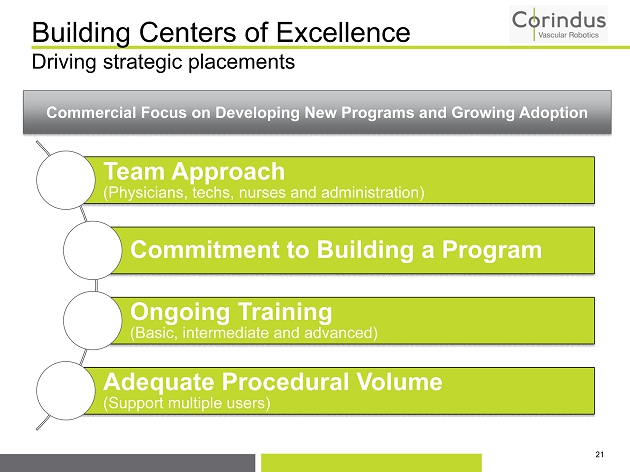
Building Centers of Excellence Driving strategic p lacements Team Approach (Physicians, techs, nurses and administration) Commitment to Building a Program Ongoing Training (Basic, intermediate and advanced) Adequate Procedural Volume (Support multiple users) Commercial Focus on Developing New Programs and Growing Adoption 21
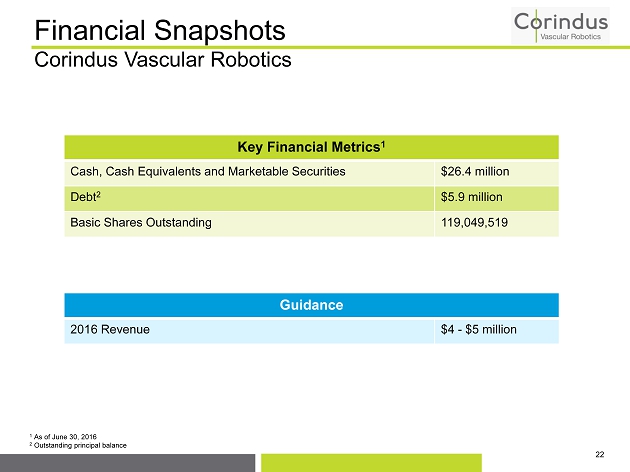
1 As of June 30, 2016 2 Outstanding principal balance Financial Snapshots Corindus Vascular Robotics Key Financial Metrics 1 Cash, Cash Equivalents and Marketable Securities $26.4 million Debt 2 $5.9 million Basic Shares Outstanding 119,049,519 Guidance 2016 Revenue $4 - $5 million 22
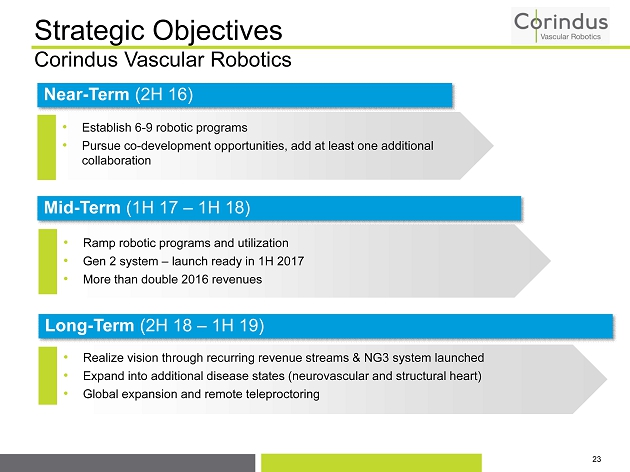
Near - Term (2H 16) • Establish 6 - 9 robotic programs • Pursue co - development opportunities, add at least one additional collaboration Mid - Term (1H 17 – 1H 18) • Ramp robotic programs and utilization • Gen 2 system – launch ready in 1H 2017 • More than double 2016 revenues Long - Term (2H 18 – 1H 19) • Realize vision through recurring revenue streams & NG3 system launched • Expand into additional disease states (neurovascular and structural heart) • Global expansion and remote teleproctoring Strategic Objectives Corindus Vascular Robotics 23
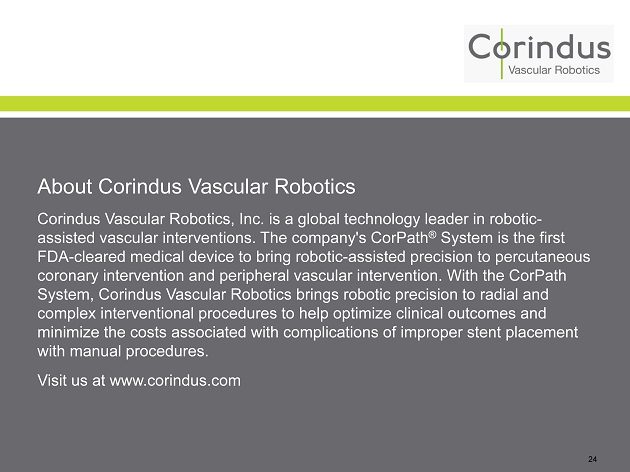
About Corindus Vascular Robotics Corindus Vascular Robotics, Inc. is a global technology leader in robotic - assisted vascular interventions. The company's CorPath ® System is the first FDA - cleared medical device to bring robotic - assisted precision to percutaneous coronary intervention and peripheral vascular intervention. With the CorPath System, Corindus Vascular Robotics brings robotic precision to radial and complex interventional procedures to help optimize clinical outcomes and minimize the costs associated with complications of improper stent placement with manual procedures . Visit us at www.corindus.com 24
